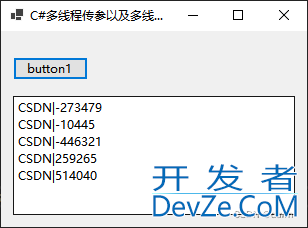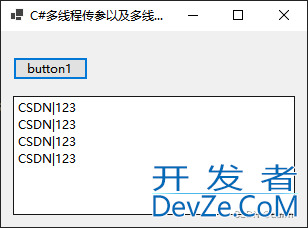详解C#中线程传参,返回值和多线程冲突问题的解决
目录
- 1、线程的单一参数传递
- 2、线程的多参数传递以及返回值
- 3、多线程可能引起的冲突
在C#中,开启一个线程很容易。
Threadandroid Th1= new Thread(func);
Th1.Start();
private void func(object Obj)
{
//处理代码
}
很多情况下,我们是需要对线程进行传递参数的,这个也简单。
1、线程的单一参数传递
private void button1_Click(object sender, EventArgs e)
{
Thread Th1= new Thread(func);
Th1.Start("CSDN");
Thread.Sleep(500);
}
private void func(object Obj)
{
string Str = Obj as string;
textBox1.BeginInvoke(new Action(() =>
{
textBox1.Text = $"传入的参数:{Str}";
}));
}
2、线程的多参数传递以及返回值
上面的例子是单一的参数,参数要求是对象,使用的时候进行了拆箱,根据上面的例子对于多参数,可以使用中间对象来处理,就是在中间对象中放置参数和获取处理后的结果。
private void button1_Click(object sender, EventArgs e)
{
FinancialInfo FI=new FinancialInfo();
FI.PersonName = "CSDN";
FI.PersonDeposit = 123;
Thread Th1 = new Thread(FI.ThreadChangeFinanceialInfo);
Th1.Start();
Thread.Sleep(500);
textBox1.Text=FI.PersonName+Environment.NewLine+FI.PersonDeposit.ToString();
}
private class FinancialInfo
{
private string Name=string.Empty;
private int Deposit=0;
public string PersonName
{
get { return Name; }
set { Name = value; }
}
public int PersonDeposit
{
get { return Deposit; }
set { Deposit = value; }
}
public void ThreadChangeFinanceialInfo()
{
this.Name = this.Name + " | C#";
this.Deposit = this.Deposit + 100;
}
3、多线程可能引起的冲突
多线程在处理同一对象时容易引起潜在的冲突,这个显而易见,例如:
private void button1_Click(object sender, EventArgs e)
{
FinancialInfo FI = new FinancialInfo();
FI.PersonName = "CSDN";
FI.PersonDeposit = 123;
Thread Th1 = new Thread(FI.ThreadAdd);
Thread Th2 = new Thread(FI.ThreadReduce);
Th1.Start();
Th2.Start();
Thread.Sleep(5000);
textBox1.Text = textBox1.Text + FI.PersonName +"|"+FI.PersonDeposit.ToString()+Environment.NewLine;
}
private class FinancialInfo
{
private string Name=string.Empty;
private int Deposit=0;
public string PersonName
{
get { return Name; }
set { Name = value; }
}
public int PersonDeposit
{
get { return Deposit; }
setphp { Deposit = value; }
}
public void ThreadAdd()
{
for (int i = 0; i < 1000000; i++)
{
this.Deposit = this.Deposit + 1;
}
}
public void ThreadReduce()
{
开发者_C入门for (int i = 0; i < 1000000; i++)
{
this.Deposit = this.Deposit - 1;
}
http://www.devze.com }
}
显示结果:

按道理, FI.PersonDeposit的值是123,加了1000000,也减了1000000,那么最终的结果应该还是123,为什么会是这样呢?
这就是多线程在处理同一对象时所产生的冲突了,产生的就是所谓的“脏数据”。
上面的代码因为等待线程执行完,进行了休眠,可以使用Task来写更简单。
var task1 = new Task(FI.ThreadAdd);
var task2 = new Task(FI.ThreadReduce);
task1.Start();
task2.Start();
Task.WaitAll(task1,task2);
Task是比Thread更加高级的概念,一个Task至少包含一个Thread。
解决上面的冲突就是对可能引起冲突的对象进行加锁判断。
完整代码:
using System;
using System.Collections.Generic;
using System.ComponentModel;
using System.Data;
using System.Drawing;
using System.Drawing.Text;
using System.Linq;
using System.Text;
using System.Threading.Tasks;
using System.Windows.Forms;
namespace MultiThread
{
public partial class Form3 : Form
编程客栈 {
private static readonly object LockObj=new object();
public Form3()
{
InitializeComponent();
}
private void button1_Click(object sender, EventArgs e)
{
FinancialInfo FI = new FinancialInfo();
FI.PersonName = "CSDN";
FI.PersonDeposit = 123;
var task1 = new Task(FI.ThreadAdd);
var task2 = new Task(FI.ThreadReduce);
task1.Start();
task2.Start();
Task.WaitAll(task1, task2);
javascript textBox1.Text = textBox1.Text + FI.PersonName +"|"+FI.PersonDeposit.ToString()+Environment.NewLine;
}
private class FinancialInfo
{
private string Name=string.Empty;
private int Deposit=0;
public string PersonName
{
get { return Name; }
set { Name = value; }
}
public int PersonDeposit
{
get { return Deposit; }
set { Deposit = value; }
}
public void ThreadChangeFinanceialInfo()
{
this.Name = this.Name + " | C#";
this.Deposit = this.Deposit + 100;
}
public void ThreadAdd()
{
for (int i = 0; i < 1000000; i++)
{
lock(LockObj)
{
this.Deposit = this.Deposit + 1;
}
}
}
public void ThreadReduce()
{
for (int i = 0; i < 1000000; i++)
{
lock(LockObj)
{
this.Deposit = this.Deposit - 1;
}
}
}
}
}
}
显示结果:

上面显示出了正确的结果,但是会耗时。
到此这篇关于详解C#中线程传参,返回值和多线程冲突问题的解决的文章就介绍到这了,更多相关C#线程内容请搜索我们以前的文章或继续浏览下面的相关文章希望大家以后多多支持我们!







 加载中,请稍侯......
加载中,请稍侯......
精彩评论